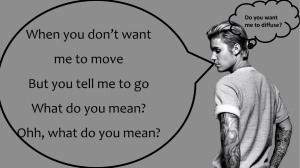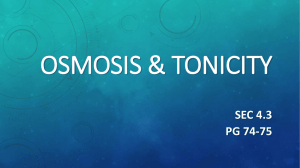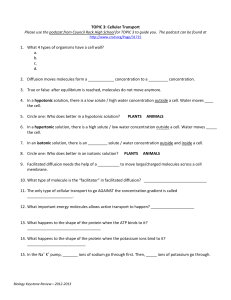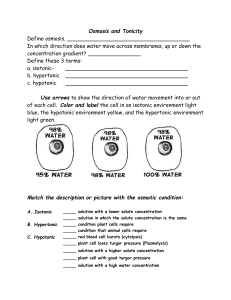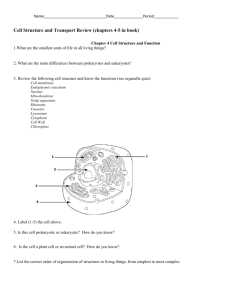Cell Membranes Osmosis and Diffusion
advertisement
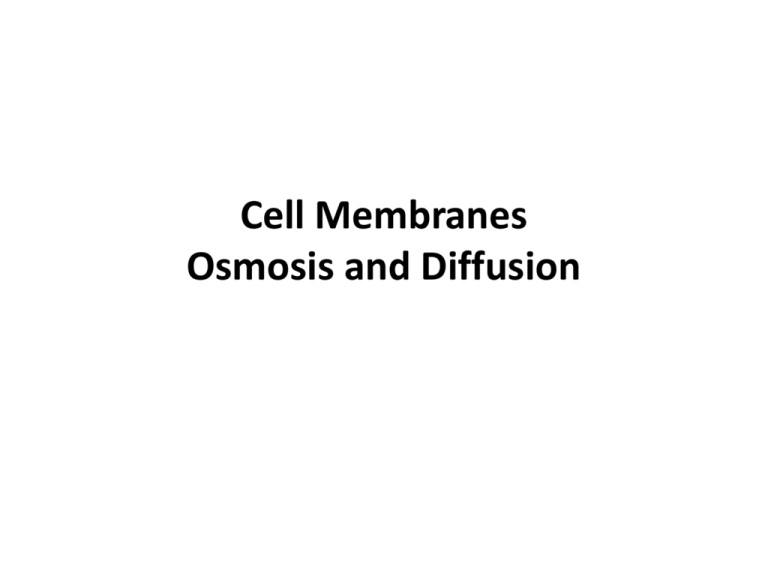
Cell Membranes Osmosis and Diffusion Functions of Membranes 1. Protect cell 2. Control incoming and outgoing substances 3. Maintain ion concentrations of various substances 4. Selectively permeable - allows some molecules in, others are kept out Phospholipid Bilayer Fluid Mosaic Model Blood-Brain Barrier • Allows some substances into the brain, but screens out toxins and bacteria • Substances allowed to cross include: water, CO2, Glucose, O2, Amino Acids, Alcohol, and antihistamines. HIV and bacterial meningitis can cross the barrier. Solutions • Solutions are made of solute and a solvent • Solvent - the liquid into which the solute is poured and dissolved. We will use water as our solvent today. • Solute - substance that is dissolved or put into the solvent. Salt and sucrose are solutes. Methods of Transport Across Membranes 1. Diffusion -passive transport – no energy expended 2. Osmosis - Passive transport of water across membrane 3. Facilitated Diffusion - Use of proteins to carry polar molecules or ions across 4. Active Transport- requires energy to transport molecules against a concentration gradient – energy is in the form of ATP Diffusion • Movement of molecules from an area of high concentration to an area of low concentration. • Movement from one side of a membrane to another, un-facilitated Passive Processes Diffusion vs. Osmosis • 1. Simple Diffusion – Gases; nonpolar; lipid soluble substances (fat-soluble vitamins) • 2. Facilitated Diffusion – Sugars (glucose; amino acids; ions) – Integral or Transmembrane proteins • Channel or carrier proteins • 3. Osmosis – Movement of water dependent on solute concentration (extracellular/intracellular) Diffusion Osmosis Tonicity is a relative term • Hypotonic Solution - One solution has a lower concentration of solute than another. • Hypertonic Solution - one solution has a higher concentration of solute than another. • Isotonic Solution - both solutions have same concentrations of solute. Plant and Animal Cells put into various solutions Tonicity • Measure of the ability of a solution to cause a change in cell shape or tone caused by osmotic flow of water • Why does osmosis occur? – Water concentration differences – Solute concentration affects water concentration • Dependent on the number (concentration) – Osmolarity – Permeability of solute molecules • Permeable to all solute molecules – equilibrium • If membrane is impermeable (see U-tube) Water Movement and Solute Concentration Reminder • Concentration- The amount of solute per unit of solvent. • Osmosis is the flow of water down the concentration gradient (from an area of high concentration to an area of low concentration) Water never stops moving, even when equilibrium has been reached. Isotonic • The net movement of water across the semipermeable membrane is equal. • The amount of water entering a cell is the same as the amount leaving the cell • Isotonic Plant cells are Flaccid. Water never stops moving, even when equilibrium has been reached. Hypotonic • There is more substances than water inside the cell. The concentration will try to even out. • Water will enter the cell. This causes the cell to swell (get larger) until it may burst. • Hypotonic Plant cells are Turgid. • The Process of swelling animal cells is called hemolysis PUTTING A CELL IN PLAIN WATER Hypertonic • There is less substances than water inside the cell. The concentration will try to even out. • Water will leave the cell. This causes the cell to shrink (get smaller) • Hypertonic Plant cells are Plasmolyzed. • The Process of shrinking animals cells is called crenation PUTTING A CELL IN SALT WATER Tonicity Concentration Water of (outside of Solute (outside cell) of cell) Net End Movement Product Isotonic Same as cell Same as cell None Hypotonic Less than cell More Cell gains than cell water Swells, turgor pressure Hypertonic More than Less Cell loses than cell water Shrinks plasmoly sis Tonicity of Solution cell None Practice • http://highered.mcgrawhill.com/sites/0072495855/student_view0/ch apter21/animation__hemolysis_and_crenatio n.html • Lets watch a clip and answer questions about red blood cells in different solutions. Types of Transport


